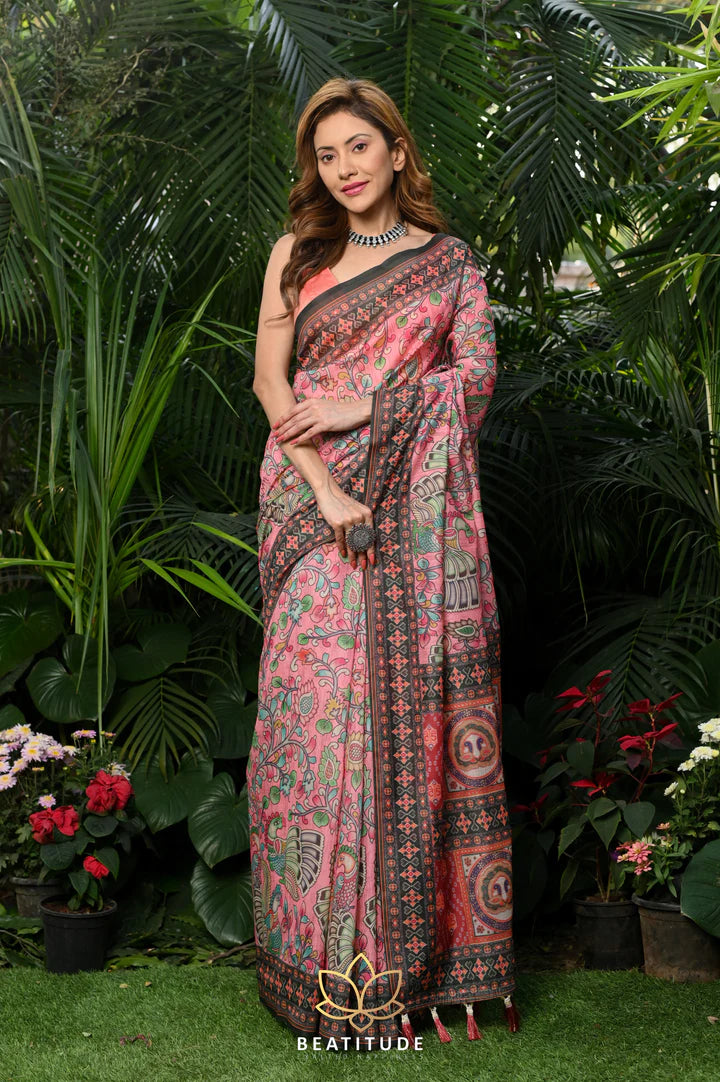Offer
Provide additional details about the offer you're running.

A saree is a very adaptable piece of apparel that may be worn in various ways to fit various events.
Sarees are commonly worn on all significant traditional occasions, even though other contemporary outfits come and go. In India, sarees are a common outfit that always highlights your greatest features.
Each traditional saree draping style is distinct and attractive, with variations according to the area.
Although they go by various names, Nauvari sarees for women are easily recognized at first glance because of their distinctive loom. The nine-yard saree is the literal translation of the well-known saree of Maharashtra.
The lower part is worn like a dhoti, with one end extending from the front to the rear between the legs. Over one shoulder, the upper end is draped like a typical saree.
The term "Namboothiri" refers to a traditional Keralan drapery style that is both old and distinctive. This appearance is still recognizable even though the saree is not draped over one shoulder as is customary.
It is the earliest surviving example of sarees covering only the lower part of the body. The neriyathu, or upper garment, is tucked into the blouse, while the mundu, or bottom garment, is worn around the waist.
The pallu is draped over the right shoulder and head before being tucked in at the waist and toward the left in this design, which originates in North-Eastern Bihar.
It stands out since there are no front pleats. They can cover their heads with this pretty traditional way of wearing a saree, and silk sarees online would look gorgeous in this style.
In various phases, this is one of the most romantic drapery patterns.
Mekhela Chadar is the name for Assamese handloom sarees that are distinctive in design and how they are worn. The saree, which young ladies typically wear, is made up of two sections.
The upper half is draped over the shoulder and tucked into the waistband, while the lower part is worn like a sarong with pleats in the front.
Compared to a regular saree, the bottom pleats have fewer pleats and are tucked to the right.
In Andhra Pradesh, senior women frequently wear this exquisite saree style. It stands out from other sarees for women because of the thin pleat at the rear and the unusual way the fabric is twisted twice around the torso, from left to right.
It nearly has a Grecian flair. After that, the pallu is taken from the front and placed loosely or around the neck. It is then slung over the right shoulder.
The saree looks better when draped in a Kappulu manner and is longer.
Coorg is a hill station in India's Western Ghats that was built specifically to simplify navigating the steep area.
The saree's end is pulled back from both shoulders and tied with a knot on the right shoulder in this style, which has rear pleats.
At weddings, brides frequently don Kanjeevaram sarees or online Banarasi sarees composed of red or gold silk.
It's also frequently called a Kodagu-style saree or Kodava clothing. This saree design is referenced even in the tales of Agasthya and Kaveri.
Wearing a saree can be scary in Tamil Nadu's sweltering heat. Therefore, the Tamil Nadu-developed method of saree draping is appropriate for hot weather.
The name "pinkosu," which literally translates to "pleats at the back," suggests that this design involves wrapping the saree around the body an additional time so that the pleats fall at the back.
The underside of the saree is seen since the pleats fall outside; therefore, the saree should be picked appropriately. Reversible handloom sarees are frequently worn in this manner. Buy organza sarees online from Beatitude.
It is one of the most recognizable-looking sarees in how it is draped and its stark white appearance, which is neatly bordered by a red line.
The pallu is thrown over the left shoulder first, then dragged forward to drape over the right shoulder when worn, and the front is box pleated.
A Bengali woman would typically fasten a ring of keys to the end of the pallu over her right shoulder to denote her status as an influential person or the head of the family.
The Hooghly town of Atpur is where the saree gets its name from. Atpur was previously well-known for making coarse sarees and dhotis for everyday use.
The Kunbi drape is a Goan saree styling method that dates back to the Portuguese and comes from the oldest Goan tribe. It is a really simple and simple-to-drape technique that manages to keep the grace and elegance of a saree.
It is simply knotted on the right shoulder and hung over the waist. The hem is knotted at an unusual height above the ankles to facilitate movement for ladies working in the fields.
The saree is typically woven with broad red and black checks, styled with a blouse, puffy sleeves, and red and green bangles.
This saree is popular among Parsi women for festivals and other special occasions.
The pallu is draped over the right and left shoulders from behind, wrapping over the blouse on the left shoulder and falling in front.
In this type of saree, the pallu is nearly as long as the hem. This look is best paired with georgette or light chiffon saree, and they frequently refer to the pallu as Gara.
Style With Beatitude
We offer tips on how to wear luxury sarees for today's women. Visit our website to see our selection of lovely sarees that make you look gorgeous. Shop online designer sarees from us and join the Beatitude family. ([https://www.facebook.com/groups/beatitudefamily/ ]).